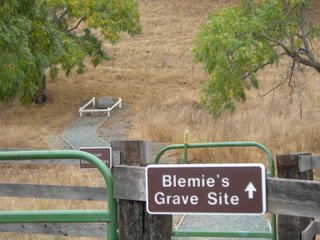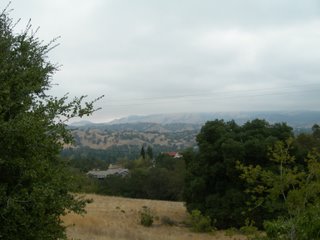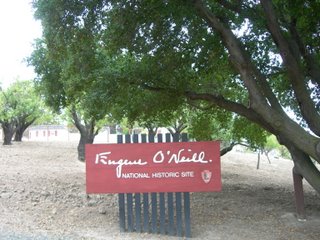Room at the Top: Eugene O'Neill's Tao House

DANVILLE, CA - Tao House was Eugene O’Neill’s only real home, and he lived in it for only six years. He remarked that it was the only place that he ever felt at home other than at sea. During this time, he wrote his final six plays, some of his best. Tao House is the only National Historic Site devoted to an American playwright.
Always a wanderer, Eugene O’Neill was a brilliant author of plays who revolutionized American drama. He won four Pulitzer Prizes and the Nobel Prize for Literature, all but one of the Pulitzers came before his time at Tao House. Yet, his personal life was unconventional and often filled with dysfunction and alienation. Born in a Broadway hotel room to a popular actor and his adoring wife, O’Neill had a father who was a hunk and a stage idol in his own right. Eugene’s mother, Ella, became a morphine addict while recovering from the difficult birth of Eugene. The family moved from hotel to hotel, so there was no real home, and his older brother Jamie provided the most influence in his early life and much of it wasn’t positive. O’Neill always felt a severe lack of communication from his parents. After several schools, day and boarding, O’Neill was asked to leave Princeton before the end of his first year. His education was of a different sort when he was said to pursue the three things that were of most interest to him: books, booze, and babes. He married three times, the first time secretly, and had three children. He did not meet his first son, Eugene Jr. until he was 12 years old. His son Shane, like his mother, was troubled and became a heroin addict. Both of his sons committed suicide. He disowned his daughter Oona after she married Charlie Chaplin when she was 18 and he was 54. Oona had already had a romantic attachment with J.D. Salinger before she met Chaplin after a visit to Tao House. Her father never spoke to her again. Never having a real home, but instead living in other people’s houses and hotels because he was always starting the production of another play, he decided with his third wife, Carlotta Monterey, that they should buy a ranch and build a secluded sanctuary where he could avoid the heightened limelight that surrounded him after winning the Nobel Prize in 1936.
Choosing California for its climate and the East Bay for its proximity to the ocean, this pair found an old ranch on the east slopes of a mountain overlooking majestic Mt. Diablo near the town of Danville. They designed and built the house which they named Tao House because of O’Neill’s love of Asian art and ideas. Here O’Neill lived a peaceful life where he could think and write uninterrupted if he chose. He wrote, swam, gardened and, of course, spent time with his beloved dog, Blemie, whose grave is grandly marked on the ranch. Declining health, especially the degenerative palsy which ultimately made it impossible for him to hold a pen, and the depression he felt about the Second World War made O’Neill increasingly cynical and discouraged, and by 1943, he had written his last play. They left the house when they could no longer find staff because neither of the O’Neills could drive and their isolation made it impossible for them to deal with Eugene’s physical degeneration by themselves.

In order to visit Tao House, which is a National Historic Site, you must make a reservation and take a special bus up the side of the mountain to the ranch. The road is winding and the destination is still quiet and above the fray even with the increased development in this San Francisco/Oakland suburb. The house is simple and presents elements of Taoism and feng shui. All but one of the ceilings are deep blue, the mirrors which fill several alcoves are colored shades of blue or green rather than being silver in order to subdue the bright reflective effect in each room.
 While the view from the front of the house is spectacular, heavy curtains and blinds were installed because of Carlotta’s sensitivity to light. O’Neill’s love of the sea is manifested everywhere. During his brief interlude in this haven from his family failures and the hellish developments leading to WW II, O’Neill wrote six plays including three of his greatest: The Iceman Cometh, A Moon for the Misgotten, and Long Day’s Journey into Night. Fearing the effects on his family since it was starkly autobiographical, O’Neill stipulated that Long Days Journey Into Night not be published or produced for 25 years after his death. Carlotta instead waited just three years. The play is O’Neill’s crowning achievement, and he presented the play to Carlotta on their twelfth wedding anniversary in 1941, with a dedication that read:
While the view from the front of the house is spectacular, heavy curtains and blinds were installed because of Carlotta’s sensitivity to light. O’Neill’s love of the sea is manifested everywhere. During his brief interlude in this haven from his family failures and the hellish developments leading to WW II, O’Neill wrote six plays including three of his greatest: The Iceman Cometh, A Moon for the Misgotten, and Long Day’s Journey into Night. Fearing the effects on his family since it was starkly autobiographical, O’Neill stipulated that Long Days Journey Into Night not be published or produced for 25 years after his death. Carlotta instead waited just three years. The play is O’Neill’s crowning achievement, and he presented the play to Carlotta on their twelfth wedding anniversary in 1941, with a dedication that read:For Carlotta, on our 12th Wedding Anniversary
Dearest: "I give you the original script of this play of old sorrow, written in tears and blood. A sadly inappropriate gift, it would seem, for a day celebrating happiness. But you will understand. I mean it as a tribute to your love and tenderness which gave me the faith in love that enabled me to face my dead at last and write this play--write it with deep pity and understanding and forgiveness for all the four haunted Tyrones.
These twelve years, Beloved One, have been a Journey into Light--into love. You know my gratitude. And my love!
Gene
Tao House
July 22, 1941.
It is fitting that this play and this place serve as enduring reminders of the triumph of the artist and of love in the face of despair, personal disaster, heartbreak, and tragedy. The solitude and simple elegance of the place holds this promise for all of us.


0 Comments:
Post a Comment
<< Home